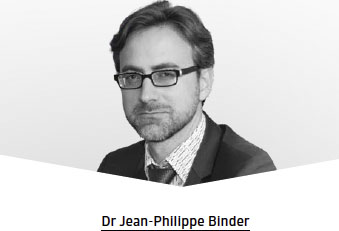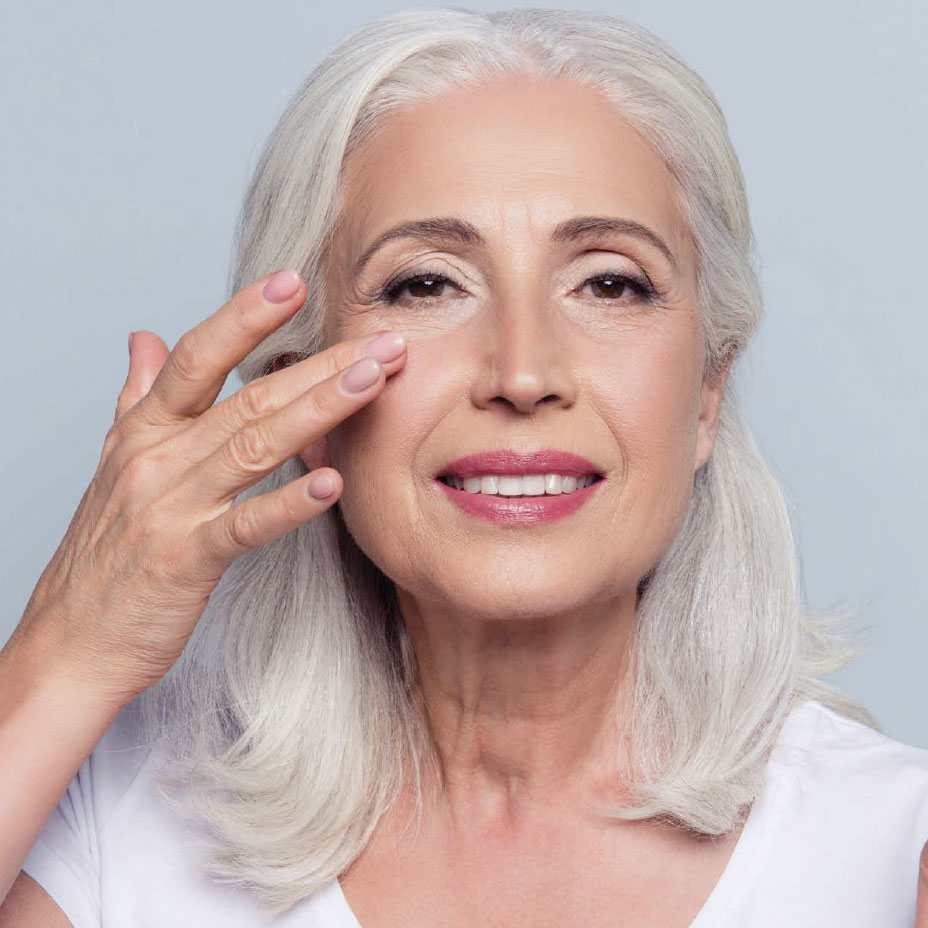By Dr Jean-Philippe Binder
How can we prevent these risk areas from deteriorating by adopting a healthy lifestyle and having suitable treatments?
Skin deteriorations are expressed by the appearance of fi ne lines then wrinkles, pigmentation issues and gradually skin sagging. The platysma muscles also weaken, and fat may accumulate in the neck area, which causes a double chin.
Cosmetic medicine treatments allow us to correct any changes at an early stage. However, when they reach an advanced stage, the sagging skin tissues and muscles require surgical treatment.
Skin deterioration and the appearance of wrinkles
In the early stages, the fi rst signs of sun-induced skin aging appear. A result of photoaging, pigmentation marks are common on the decolletage. They can be treated with pulsed light, vascular and pigmentary lasers, or some superficial peels.
Fine lines appear next and require specific treatments which are, in the first instance, non-surgical:
1. “Skinbooster” type injections: Treatment involves injecting weakly cross-linked hyaluronic acid (for example Volite from Allergan) whose aim is not a volumising effect but rather to hydrate the skin in depth. The injections are made using the nappage technique deep within the skin.
2. “Mesolift” type injections: We can blend hyaluronic acid with vitamins and trace elements (for example NCTF 135 HA from Filorga). This product allows us to correct any superficial wrinkles and acts as a complexion booster. It hydrates and revitalises the skin in depth, especially dull and tired skin. It also improves the dermal elasticity, firmness and tonus.
3. Radiofrequency with ultrasounds: Used on the early signs of skin sagging, this technique involves using the heating power of radiofrequency on the collagen and elastin fibres in the dermis to lift and firm up the skin.
4. Superficial, light peels containing glycolic acid (and other fruit acids): This is an exfoliating chemical treatment that rids the skin of dead cells to promote cell regeneration and make the skin smoother.
Mild or moderate skin sagging
1. Peels: Superficial or medium peels with trichloroacetic acid (TCA), without exceeding 20% concentration and being very careful, given the skin’s fragile state.
2. Rejuvenation or fractional lasers to heat up the skin and stimulate collagen production. Given the fragility of the skin, we must be wary of too-ablative lasers which can be too aggressive.
3. Hyaluronic acid injections, medium cross-linked, to address wrinkles on the neck or decolletage.
4. Micro lipofilling or nanofat: The idea is to carry out a small liposuction procedure and centrifuge the fat to purify the fat cells (adipocytes) then reinject them just under the skin. The growth factors contained in the fat help with skin rejuvenation.
5. Tensor threads: These resorbable polylactic acid threads are equipped with cones that hook onto the tissues like Velcro. They lift the fi brosis-inducing tissues and stimulate collagen production, which causes the tissues to retract. Their life span is 18 to 36 months.
Significant skin sagging
 After age 50, ptosis in the face is more marked, the neck sags and jowls appear. Significant sagging can only be treated through surgery. This is the most effective method for treating sagging in the tissues in the lower face and neck. A lift is rarely li-mited to the neck: we generally carry out a cervicofacial lift which treats the cheeks, oval and neck. The theory behind a lift is that it pulls the excess skin upwards and back-wards. It often includes pulling the platysma muscles backwards and fixing them to enhance the lifting effect and make it last longer. This action on the muscles is important because it improves the skin’s support structure. As well as a cervicofacial lift, we might perform liposuction under the chin. It might also be neces-sary to reinject some autologous fat (lipo-fi lling) to counter any facial flaws.
After age 50, ptosis in the face is more marked, the neck sags and jowls appear. Significant sagging can only be treated through surgery. This is the most effective method for treating sagging in the tissues in the lower face and neck. A lift is rarely li-mited to the neck: we generally carry out a cervicofacial lift which treats the cheeks, oval and neck. The theory behind a lift is that it pulls the excess skin upwards and back-wards. It often includes pulling the platysma muscles backwards and fixing them to enhance the lifting effect and make it last longer. This action on the muscles is important because it improves the skin’s support structure. As well as a cervicofacial lift, we might perform liposuction under the chin. It might also be neces-sary to reinject some autologous fat (lipo-fi lling) to counter any facial flaws.
Platysma bands
The platysma bands (“turkey neck”) are the front edges of the platysma muscles. They stretch from the jaw to just above the collarbone, on the front/side of the neck. With time, the left and right muscles move apart and stick out underneath the skin, leading to platysma bands.
A clinical examination is carried out to evaluate the muscular element by asking the patients to bite their teeth together while opening their lips. If the bands become more prominent, it is a muscular problem that can be treated with botulinum toxin injections into the platysma muscles.
If the bands look the same and are only slightly accentuated or unchanged by this muscle contraction, it means that the edges of the muscles have distended the skin so much that it cannot spring back to its original position on its own. In this case, treatment is surgical and requires a cervical or cervicofacial lift, which involves surgically tightening the platysma muscles.
Double chin
This is a fatty deposit under the chin which often results from a combination of factors. It can be treated with cryolipolysis, which involves destroying and eliminating the adipose tissues with cold. Radiofrequency can also reduce a double chin. Treatment can also be surgical, which means liposuction under the chin. This operation involves sucking fat out across the neck, via holes under the chin and behind the ear.
Once the fat volume has been lost, the skin retracts. Liposuction might also be combined with a cervicofacial lift when the double chin is associated with other signs of facial aging, or with a forward-sliding genioplasty corrected by osteotomy or with hyaluronic acid injections into the chin.
Excess skin under the jaw
If there is a large amount of excess skin underneath the jaw, the direct excision of any excess skin in the centre of the neck is a straightforward surgical solution, which leaves a scar running vertically down the centre of the neck.
Oval of the face and jowls
When the jowls are not too prominent, we can cheat by injecting a filler product around the jowl, i.e., between the jowl and the chin and to the outer side of the jowl, possibly continuing the injections towards the cheek if necessary, in order to restore the oval of the face. This can be done by injecting hyaluronic acid or reinjecting autologous fat (lipofilling) if we want a result that is stable over the long term.If there is more excess fat, localised liposuction may be required.Finally, in the case of a large amount of excess fat, combined with significant sagging of the skin and facial tissues, a cervicofacial lift is required.
 Dr Jean-Philippe Binder: Plastic surgeon in Paris for 20 years. Works part-time at the Curie Institute and in private practice. Specialises in cosmetic medicine and surgery, microsurgery, breast reconstruction. Member of the SOFCPRE (French Society of Plastic, Reconstructive and Aesthetic Surgery).
Dr Jean-Philippe Binder: Plastic surgeon in Paris for 20 years. Works part-time at the Curie Institute and in private practice. Specialises in cosmetic medicine and surgery, microsurgery, breast reconstruction. Member of the SOFCPRE (French Society of Plastic, Reconstructive and Aesthetic Surgery).
More informations : dr-binder.fr















